Related Research Articles

The Monster Manual is the primary bestiary sourcebook for monsters in the Dungeons & Dragons fantasy role-playing game, first published in 1977 by TSR. The Monster Manual was the first hardcover D&D book and includes monsters derived from mythology and folklore, as well as creatures created specifically for D&D. Creature descriptions include game-specific statistics, a brief description of its habits and habitats, and typically an image of the creature. Along with the Player's Handbook and Dungeon Master's Guide, the Monster Manual is one of the three "core rulebooks" in most editions of the D&D game. As such, new editions of the Monster Manual have been released for each edition of D&D. Due to the level of detail and illustration included in the 1977 release, the book was cited as a pivotal example of a new style of wargame books. Future editions would draw on various sources and act as a compendium of published monsters.
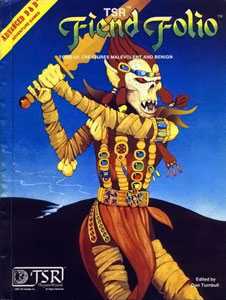
Fiend Folio is the name of three separate products published for successive editions of the fantasy role-playing game Dungeons & Dragons (D&D). All three are collections of monsters.

The Player's Handbook is the name given to one of the core rulebooks in every edition of the fantasy role-playing game Dungeons & Dragons (D&D). It does not contain the complete set of rules for the game, and only includes rules for use by players of the game. Additional rules, for use by Dungeon Masters (DMs), who referee the game, can be found in the Dungeon Master's Guide. Many optional rules, such as those governing extremely high-level players, and some of the more obscure spells, are found in other sources.
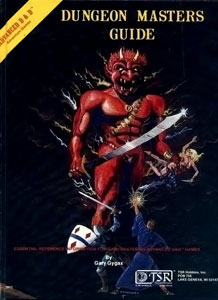
The Dungeon Master's Guide is a book of rules for the fantasy role-playing game Dungeons & Dragons. The Dungeon Master's Guide contains rules concerning the arbitration and administration of a game, and is intended for use by the game's Dungeon Master.

Expedition to the Barrier Peaks is a 1980 adventure module for the Dungeons & Dragons role-playing game written by Gary Gygax. While Dungeons & Dragons (D&D) is typically a fantasy game, the adventure includes elements of science fiction, and thus belongs to the science fantasy genre. It takes place on a downed spaceship; the ship's crew has died of an unspecified disease, but functioning robots and strange creatures still inhabit the ship. The player characters fight monsters and robots, and gather the futuristic weapons and colored access cards that are necessary for advancing the story.
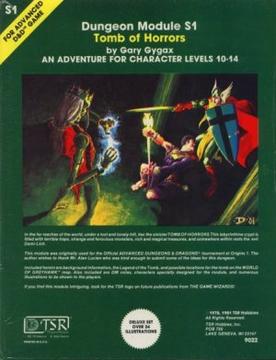
Tomb of Horrors is an adventure module written by Gary Gygax for the Dungeons & Dragons (D&D) role-playing game. It was originally written for and used at the 1975 Origins 1 convention. Gygax designed the adventure both to challenge the skill of expert players in his own campaign and to test players who boasted of having mighty player characters able to best any challenge. The module, coded S1, was the first in the S-series, or special series of modules. Several versions of the adventure have been published, the first in 1978, and the most recent, for the fifth edition of D&D, in 2017 as one of the included adventures in Tales from the Yawning Portal. The module also served as the basis for a novel published in 2002.

Dungeonland (EX1) is a 1983 adventure module for the Dungeons & Dragons (D&D) roleplaying game, written by Gary Gygax for use with the First Edition Advanced Dungeons & Dragons (AD&D) rules. It is an adaptation of Lewis Carroll's 1865 novel Alice's Adventures in Wonderland, with the various characters from the book translated into AD&D terms.

Ravenloft is an adventure module for the Dungeons & Dragons (D&D) fantasy role-playing game. The American game publishing company TSR, Inc. released it as a standalone adventure booklet in 1983 for use with the first edition Advanced Dungeons & Dragons game. It was written by Tracy and Laura Hickman, and includes art by Clyde Caldwell with maps by David Sutherland III. The plot of Ravenloft focuses on the villain Strahd von Zarovich, a vampire who pines for his lost love. Various story elements, including Strahd's motivation and the locations of magical weapons, are randomly determined by drawing cards. The player characters attempt to defeat Strahd and, if successful, the adventure ends.

Chaos: The Battle of Wizards is a turn-based tactics video game released for the ZX Spectrum in 1985. It was written by Julian Gollop and originally published by Games Workshop. Based on Gollop's 1982 design for a board game / card game hybrid, Chaos received a positive reception and went on to influence various games, including Darwinia and King's Bounty, and spawned a sequel, Lords of Chaos, in 1990.

In Search of the Unknown is a module for the Dungeons & Dragons roleplaying game, designed for use with the Basic Set of rules. It was written by game designer Mike Carr and was first published in 1978 by TSR, Inc. The module details a hidden complex known as the Caverns of Quasqueton. Reviewers considered it a good quality introduction to the game that was written in the so-called dungeon crawl style, where the primary goal of the players is the exploration of a dangerous labyrinth to battle monsters and obtain treasure.
In the Dungeons & Dragons fantasy role-playing game, the mimic is a type of fictional monster. It is portrayed as being able to change its shape to disguise its body as an inanimate object, commonly a chest. The mimic uses a powerful adhesive that holds fast to creatures that touch it, allowing the mimic to beat its victims with its powerful pseudopods. The mimic was introduced in the first edition Advanced Dungeons & Dragons game's original Monster Manual. The mimic has appeared in subsequent editions. Several variants of the creature have been introduced, with a variety of abilities and sizes.

Descent Into the Depths of the Earth is an adventure module for the Dungeons & Dragons (D&D) fantasy roleplaying game coded D1–2. It was written by Gary Gygax, and combines two previously published modules from 1978, the original Descent into the Depths of the Earth and Shrine of the Kuo-Toa. A sequel to the first two modules, Vault of the Drow, was also published in 1978. All of these D-series modules were produced for use with the 1st edition Advanced Dungeons & Dragons (AD&D) rules.
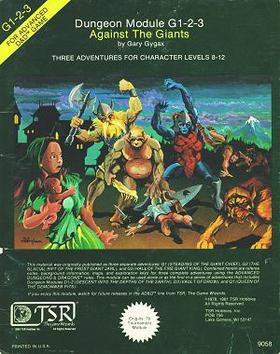
Against the Giants is an adventure module written by Gary Gygax and published by TSR in 1981 for the Dungeons & Dragons fantasy role-playing game. It combines the G series of modules previously published in 1978: Steading of the Hill Giant Chief, Glacial Rift of the Frost Giant Jarl, and Hall of the Fire Giant King. All three were produced for use with the 1st edition Advanced Dungeons & Dragons rules. In 1999, to recognize the 25th anniversary of TSR, the company released an updated version, Against the Giants: The Liberation of Geoff. Later in 1999, Wizards of the Coast published a novelization of Against the Giants by Ru Emerson.

High Fantasy is a fantasy role-playing game system originally published by Fantasy Productions in 1978. A second edition in 1981 and several subsequent books were published by Reston Publishing that featured solo adventures using the High Fantasy system. The game received mixed reviews in game periodicals including White Dwarf, The Space Gamer, Different Worlds, Ares, and Dragon.
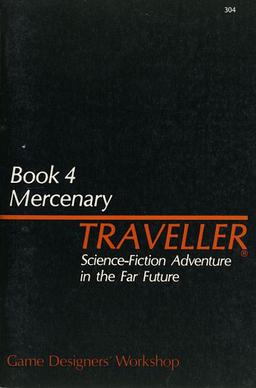
Traveller Book 4: Mercenary is a 1978 role-playing game supplement for Traveller published by Game Designers' Workshop.

Wizard's Quest is a fantasy board wargame published by Avalon Hill in 1979.
Swordquest is a 1979 board game published by Task Force Games.

Ice War is a board wargame published by Metagaming Concepts in 1978 that hypothesizes a Eurasian attack against American oilfields in Alaska.

Labyrinthine is a fantasy board game published by Wee Warriors in 1977. Based on themes taken from the then-newly published Dungeons & Dragons, Labyrinthine was the first "dungeon crawler" board game to use a totally modular board that was reconfigured for each game.
References
- 1 2 Howe, Norman S. (March–April 1979). "Spellmaker & Quest". The Space Gamer . Metagaming (22): 26.
- 1 2 Boegman, Bruce (October 1979). "The Dragon's Augury". Dragon . TSR, Inc. (30): 34.
- ↑ Turnbull, Don (April–May 1979). "Open Box". White Dwarf . Games Workshop (12): 14.
- ↑ "GAMES Magazine #14". November 1979.